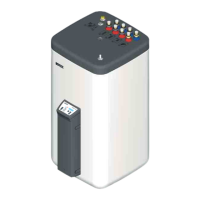7 x Faults and malfunctions
FA ROTEX Solaris RPS4 - 06/2015
35
Sensor-specific error messages
The Solaris R4 controller reacts as follows to cable breaks and for
short circuits in sensors or sensor cables (see tab. 7-2):
– A flashing code letter in the display indicates the fault in the
status column and a message appears.
– The lamp associated with the fault flashes.
– In addition, the control unit automatically intervenes in system
operation.
All other sensor values remain accessible via the arrow keys.
Tab. 7-2 Sensor fault table
7.2 Troubleshooting
Operating events similar to faults
The storage tank temperature "T
S
" in the solar storage tank
reaches the value set in the parameter "TS max":
– Pumps are switched off, the system is drained. In the Solaris
R4 controller, the T
S
lamp flashes, the display shows the
measured storage tank temperature. As soon as the storage
cylinder temperature falls more than 2 K, normal system
operation is resumed.
The temperature in the solar panel is higher than the restarting
protection temperature "TK perm":
– Pumps are switched off. The T
K
lamp flashes in the Solaris
R4 controller. If the set switch-on inhibit temperature falls by
more than 2 K, normal system operation is enabled automat-
ically.
Failures
The T
R
lamp flashes in the Solaris R4 controller. Return temper-
ature "T
R
" is greater than 40 °C and is 10 K higher than the
storage temperature "T
S
". The solar operating pump P
S
is
switched off. The cause is a defective or incorrectly connected
sensor.
Ɣ Install the sensor correctly or replace it; normal system
operation will be resumed.
"W" flashes in the status column on the Solaris R4 controller. The
minimum flow rate start phase "V1" at the FlowSensor
(see page 23, tab. 6-1) is not achieved after switching on the
solar operating pump P
S
and after expiry of the time defined by
the parameter "Time P2" (fig. 6-3).
Î The system goes to temporary blocking for 2 hours (solar
operating pump P
S
is switched off), but still tries to restart
automatically after the blocking time.
Î If this event occurs three times in a row, without interme-
diate starting, the solar operating pump P
S
is switched off
for an extended period and the status "F" is set.
"F" flashes in the status column on the Solaris R4 controller. The
minimum flow rate start phase "V1" at the FlowSensor
(see page 23, tab. 6-1) is not achieved after switching on the
solar operating pump P
S
and after expiry of the time defined by
the parameter "Time P2" (fig. 6-3). The solar operating pump P
S
is switched off.
Ɣ If a leak is suspected, examine the solar system, rectify faults
and then release the block by "Switching OFF/ON" on the
controller.
Sensor Cause of the fault Status
(blinks)
Display Lamp
(flashing)
Consequence
Collector temp.
Interruption K uuuu T
K
Long-term switch-off
of P
S
Short circuit –––– T
K
Return flow temp.
Interruption R uuuu T
R
Short circuit –––– T
R
Storage cylinder temp.
Interruption S uuuu T
S
Short circuit –––– T
S
Inflow temp. Voltage drop V –––– without lamp
Operation without FlowSensor
FlowSensor Voltage drop D –––– without lamp
Hereby, short-term evaporation in the collectors is pos-
sible. The pressureless steam escapes into the storage
cylinder. On rare occasions, small volumes of water
vapour come out of the solar storage tank for short peri-
ods.
WARNING!
Live parts can cause an electric shock on contact and
cause life-threatening burns and injuries.
Ɣ Electrical installations must always be carried out
by qualified electrical technicians in conformity
with the relevant electrical guidelines and the
regulations of the electric utilities company to
prevent hazards from damaged electric wiring.
Ɣ Rectification of damage to live components of the
Control and pump unit RPS4 must only be carried
out by heating engineers authorised and recog-
nised by the energy supply company.
Ɣ Before beginning the repair work, disconnect the
Control and pump unit RPS4 from the power
supply (fuse, shut off main switch) and secure
against unintentional restart.
Ɣ Comply with the relevant safety at work regula-
tions.
CAUTION!
Danger of burning on hot surfaces.
Ɣ Let the device cool down for a reasonably long
time before maintenance and inspection work.
Ɣ Wear protective gloves.

